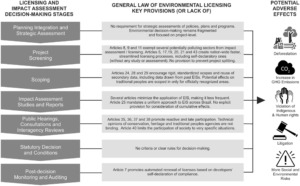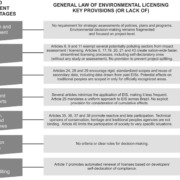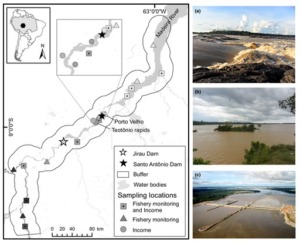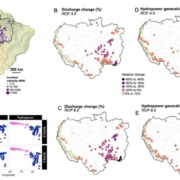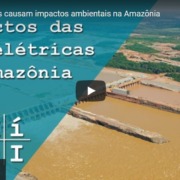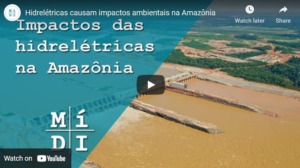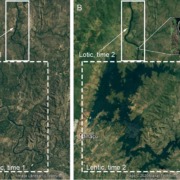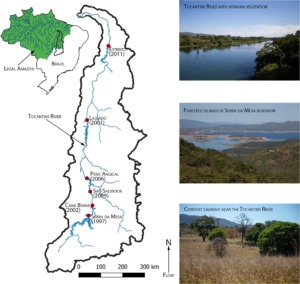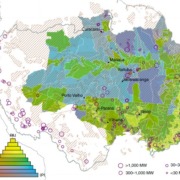
Authors: Jussara Santos Dayrell, William Ernest Magnusson, Paulo Estefano Dineli Bobrowiec, Albertina Pimentel Lima
Citation: Dayrell JS, Magnusson WE, Bobrowiec PED, Lima AP (2021) Impacts of an Amazonian hydroelectric dam on frog assemblages. PLoS ONE 16(6): e0244580. https://doi.org/10.1371/journal.pone.0244580
Pesquisadores do Instituto Nacional de Pesquisas da Amazônia (INPA) realizaram uma pesquisa pioneira na avaliação de longo prazo dos impactos de uma mega hidrelétrica, localizada na Amazônia brasileira, sobre as comunidades de sapos. Jussara Dayrell enviou o texto abaixo sobre artigo, o primeiro derivado de sua tese de doutorado:
.
“Os levantamentos de fauna associados às avaliações de impacto ambiental da hidrelétrica de Santo Antônio (Rondônia) estão entre os mais intensivos, bem planejados e de longo prazo já realizados no Brasil. É uma hidrelétrica com turbinas do tipo bulbo que requerem menos água e produzem um reservatório de tamanho reduzido (271 km2). Foi usada a base de dados do Monitoramento da Herpetofauna, compilado entre 2010 e 2017. Os dados foram coletados 2 anos antes, em áreas posteriormente inundadas pela hidrelétrica (estágio pré-inundado) e não inundadas (pré-não inundado), com intervalos logo após o enchimento (pós 1) e 2 anos depois do enchimento (pós 2).
.
Registramos 96 espécies de sapos. O enchimento da barragem da hidrelétrica teve pouco efeito no número de espécies. A composição de sapos nas áreas permanentemente inundadas pelo barramento do rio não se restabeleceu nas áreas remanescentes e 6% das espécies não foram mais registradas. As hidrelétricas de Santo Antônio e Jirau inundaram 118 km² de floresta de várzea. Com isso, nossos resultados mostram a necessidade de proteção das florestas de várzea afetadas por barramentos de hidrelétricas.
.
Nas áreas não inundadas, também houve mudanças na composição de espécies ao longo do tempo, com o ganho de espécies em 82% das parcelas amostradas, principalmente naquelas localizadas próximas da nova margem do rio Madeira. Esse aumento no número de espécies nas áreas remanescentes pode ser uma resposta à inundação das áreas baixas, pois, após o enchimento do reservatório, os sapos podem ter se deslocado às áreas mais próximas, aumentando o número de espécies registradas. Isso ocorre no período de reestruturação da comunidade após uma perturbação, onde algumas populações podem diminuir enquanto outras ocupam os novos ambientes.”
.
Para ler o artigo: https://doi.org/10.1371/journal.pone.0244580

ABSTRACT
About 90% of the Amazon’s energy potential remains unexploited, with many large hydroelectric dams yet to be built, so it is important to understand how terrestrial vertebrates are affected by reservoir formation and habitat loss. We investigated the influence of the construction of the Santo Antônio Hydroelectric dam on the Madeira River in southwestern Amazonia on the structure of frog assemblages based on samples collected in two years before the dam flooded (pre-stage) and one (post1-stage) and four years (post2-stage) after its construction. We surveyed five 500-ha plot systems three times during each stage; in the pre-stage we sampled 19 plots in low-lying areas that would be flooded by the dam, (from now called flooded pre-stage plots) and 45 plots in terra-firme forest (from now called unflooded pre-stage plots). At the post1-stage we sampled the 45 unflooded plots and in the post2-stage we sampled the remaining 39 unflooded plots. We detected frogs by active visual and acoustic searches standardized by both time and sampling area. Few species recorded in the pre-stage flooded plots were not found in the pre-stage unflooded plots or in stages after flooding. However, the composition of frog assemblages based on relative densities in flooded pre-stage plots did not re-establish in plots on the new river margins. In unflooded areas, frog assemblages were distinct among the flooding stages with no tendency to return to the original assemblage compositions even four years after the dam was filled. For the areas that were not flooded, there was an increase in species richness in 82% of the plots between the surveys before dam construction and the first surveys after dam completion, and 65% between the pre-stage and surveys four years after dam completion. Lack of understanding by the controlling authorities of the long-term effects of landscape changes, such as water-table rises, means that studies covering appropriate periods post construction are not required in legislation, but the data from Santo Antônio indicate that changes due to dam construction are either long-term or difficult to distinguish from natural fluctuations. Future environmental-impact studies should follow strict BACI designs.
